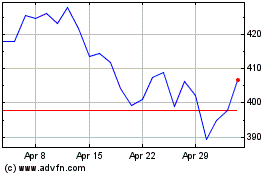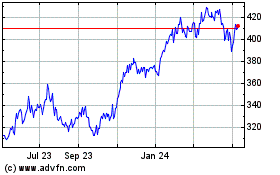Your Snack's Crunch Is Cloud-Verified -- WSJ
November 26 2018 - 3:02AM
Dow Jones News
Australian food company uses connected device to detect soggy
snacks
By Mike Cherney
This article is being republished as part of our daily
reproduction of WSJ.com articles that also appeared in the U.S.
print edition of The Wall Street Journal (November 26, 2018).
BRISBANE, Australia -- To make a snack with the perfect crunch,
one company is turning to the cloud.
Majans Pty, which makes pea- and nut-based snacks in Australia,
is teaming up with Microsoft Corp. and others to test a system that
uses a beam of light to measure moisture and salt levels, then
uploads that data in real time to the cloud. If successful, it
could allow factory managers to instantly detect an issue in
production -- possibly with just an alert on their smartphones.
Too much moisture can lead to an unsatisfying crunch, a big
problem for snack companies that have just one bite to impress
consumers. But current methods often require a technician to scoop
snacks off a conveyor belt, bring the sample into a lab and use a
special machine to get a moisture reading. At Majans, that test is
only done every one to two hours, potentially overlooking flawed
product.
"Moisture is the enemy of crunchy snacks," said Mathew
Barbagallo, the chief commercial officer at family-owned, privately
held Majans, which sells its snacks in the U.S. as well as
Australia. The crunch "triggers certain sensors in the brain to add
a level of enjoyment. The crunchier, the better."
Since batches of snacks are sometimes unfit for sale if they're
too soggy, better data from the factory floor can help reduce waste
and save money. Ensuring snacks are sufficiently crunchy can also
help food makers succeed in an industry where competition is
intensifying. Health-conscious consumers are embracing everything
from date-based protein balls to roasted fava beans, a trend that
is pushing manufacturers to look beyond potato chips and make
crunchy snacks from a wider range of foods, like kale and
seaweed.
A survey conducted earlier this year by market research firm IRI
found that 50% of U.S. consumers eat snacks that "add excitement to
their daily diet." That was a 19-point jump from a similar survey
two years prior, suggesting that many consumers are looking for
more variety in their snacks. IRI expected snacks based on beans
and chickpeas to be fast-growing categories.
Food companies that tap into shifting consumer tastes -- and use
technology to ensure a compelling crunch -- could grab a bigger
slice of the growing U.S. snack market, which research firm
IBISWorld estimates is worth nearly $43 billion in revenue this
year. The market is projected to increase 4.2% annually over the
next five years, up from 3.7% in the previous five-year period.
One day earlier this month, a conveyor belt ferried a
barbecue-flavored, tapioca-based shrimp cracker around Majans's
Australian factory. The conveyor passed under a device, called a
spectrometer, that determines moisture content by beaming light
onto the snacks and measuring what is reflected back. The
information was then displayed on a computer screen in an office
overlooking the factory floor.
"That's gold, that data," said Phil Dahlenburg, the
manufacturing manager at Majans, as he watched results from the
machine appear on the computer screen.
The spectrometer, made by a unit of German manufacturer Zeiss
Group, costs roughly $40,000, and is already used by other
companies to assess potato products and tobacco. But Microsoft says
the Majans plant is the first time it has connected a device like
this in a snack factory to the cloud -- which is being used to
bring everything from refrigerators to livestock and beer kegs
online.
Measuring moisture content "moves the game quite a fair bit"
from traditional, lab-based methods, said Angeline Achariya, chief
executive at the Monash Food Innovation Centre, a unit of a local
university in Melbourne, Australia. "Every company is looking for
technologies that can give them much more real-time data."
In general, some 3% to 5% of snacks produced in a factory might
be unfit for sale due to production issues, Mr. Dahlenburg
estimates. Depending on the severity, manufacturers might be able
to blend an irregular batch of snacks with future production runs
to recoup some losses, or use bad batches in livestock feed.
After collecting a sample for a moisture test using the
traditional machine, a technician needs to grind it up and feed it
into the device -- which can take six minutes or more to spit back
a reading.
In contrast, the cloud-connected spectrometer can offer readings
every two seconds and deliver that data to a computer nearly
instantaneously. If found to be reliable enough, Majans could
install more of the devices in a new factory being developed.
"That crunch is a promise" to customers, said Amit Raniga, a
director at Majans. "You can't compromise on that."
Write to Mike Cherney at mike.cherney@wsj.com
(END) Dow Jones Newswires
November 26, 2018 02:47 ET (07:47 GMT)
Copyright (c) 2018 Dow Jones & Company, Inc.
Microsoft (NASDAQ:MSFT)
Historical Stock Chart
From Mar 2024 to Apr 2024

Microsoft (NASDAQ:MSFT)
Historical Stock Chart
From Apr 2023 to Apr 2024
